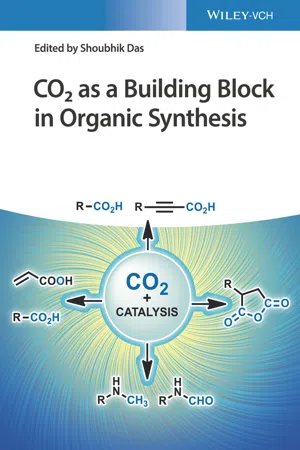
- English
- ePUB (mobile friendly)
- Available on iOS & Android
CO2 as a Building Block in Organic Synthesis
About This Book
A guide to the fascinating application of CO 2 as a building block in organic synthesis
This important book explores modern organic synthesis'use of the cheap, non-toxic and abundant chemical CO 2 as an attractive C1 building block. With contributions from an international panel of experts, CO 2 as a Building Block in Organic Synthesis offers a review of the most important reactions which use CO 2 as a building block in organic synthesis.
The contributors examine a wide-range of CO 2 reactions including methylation reactions, CH bond functionalization, carboxylation, cyclic carbonate synthesis, multicomponent reactions, and many more. The book reviews the most recent developments in the field and also:
- Presents the most important reactions like CH-bond functionalization, carboxylation, carbonate synthesis and many more
- Contains contributions from an international panel of experts
- Offers a comprehensive resource for academics and professionals in the field
Written for organic chemists, chemists working with or on organometallics, catalytic chemists, pharmaceutical chemists, and chemists in industry, CO 2 as Building Block in Organic Synthesis contains an analysis of the most important reactions which use CO 2 as an effective building block in organic synthesis.
Frequently asked questions
Information
1
Photochemical and Substrate‐Driven CO 2 Conversion
1.1 Introduction
Table of contents
- Cover
- Table of Contents
- 1 Photochemical and Substrate‐Driven CO 2 Conversion
- 2 C–H Carboxylations with CO 2
- 3 Transition‐Metal‐Catalyzed C–H Carboxylation
- 4 Fixation of CO2 in Organic Molecules with Heterogeneous Catalysts
- 5 CO 2 Fixation into Organic Molecules via Carbon–Heteroatom Bond Formation
- 6 Carbonyl‐Ene Reactions of Alkenes with Carbon Dioxide
- 7 Recent Advances in Electrochemical Carboxylation of Organic Compounds for CO2 Valorization
- 8 Photocatalysis as a Powerful Tool for the Utilization of CO2 in Organic Synthesis
- 9 Direct Carboxylation of Alkenes and Alkynes
- 10 Homogeneous Iron Catalysts for the Synthesis of Useful Molecules from CO2
- 11 NHC‐catalyzed CO 2 Fixations in Organic Synthesis
- 12 Silver‐Catalyzed CO2 Fixation
- Index
- End User License Agreement